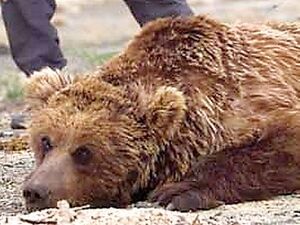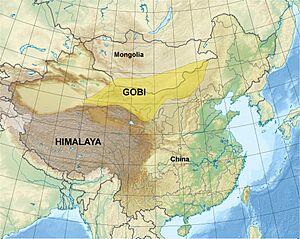Gobi bear facts for kids
Quick facts for kids Ursus arctos gobiensis |
|
|---|---|
 |
|
| Conservation status | |
| Scientific classification |
|
| Kingdom: | Animalia |
| Phylum: | Chordata |
| Class: | Mammalia |
| Order: | Carnivora |
| Family: | Ursidae |
| Genus: | Ursus |
| Species: | |
| Subspecies: |
U. a. gobiensis
|
| Trinomial name | |
| Ursus arctos gobiensis Sokolov & Orlov, 1920
|
|
The Gobi bear (Ursus arctos gobiensis) is a special type of brown bear. It is known as the Mazaalai (Мазаалай) in Mongolian. These bears live in the Gobi Desert in Mongolia. They are listed as critically endangered, which means they are very close to disappearing forever.
Only about 31 Gobi bears are left in the wild. Their numbers have stayed about the same for a while. However, there are many more male bears than female bears. Gobi bears live far away from other brown bears. This means they cannot breed with other brown bear groups. Hunting them was banned in 1959 to help save this rare animal.
Contents
What Do Gobi Bears Eat and Look Like?
Gobi bears mostly eat plants. Their diet includes roots, berries, and other plant parts. Sometimes, they might eat small rodents. There is no proof that they hunt large animals. Only a small part of their diet, about 8%, comes from animal protein.
Gobi bears are smaller than most other brown bears. Adult male Gobi bears weigh about 96 to 138 kilograms (212 to 304 pounds). Female bears are smaller, weighing about 51 to 78 kilograms (112 to 172 pounds).
How Gobi Bears Survive in the Desert
Gobi bears are the only bears that have learned to live in a very hot desert. They have adapted to this extreme climate. Their DNA shows they have very little genetic diversity. This means their genes are quite similar to each other. This low diversity is a problem because it can make their DNA fragile. It also affects their ability to reproduce.
This low genetic diversity is because the Gobi bear population is very small. They are also very isolated from other bear groups. Only a few other small brown bear groups, like those in the Pyrenees Mountains, have such low genetic diversity.
Protecting the Gobi Bear
Gobi bears live in a small area of about 23,600 square kilometers (9,100 square miles). This area is always close to water sources. They are separated from other bear groups by deserts, farms, and human towns.
Helping Gobi Bears Find Food
Since 1985, there has been a special program to help Gobi bears. This program gives them extra food. Pellets made of wheat, corn, carrots, and turnips are left for them. These feeders are placed near waterholes in the Great Gobi Strictly Protected Area. This helps the bears find enough food, especially when natural food is scarce.
Research on Gobi Bear Ancestry
Scientists have studied the DNA of Gobi bears. Some early studies thought Gobi bears might be related to the Tibetan blue bear or Himalayan brown bear. However, newer and more detailed DNA tests show something different. These tests reveal that Gobi bears and Himalayan brown bears are unique groups. They share a very old ancestor, making them one of the oldest brown bear groups.
Scientists have found that Gobi bears have very similar DNA among themselves. This supports the idea that they are isolated. It means they do not mix with other brown bear populations.
Current Population and Efforts
Between 2007 and 2018, scientists found 51 different bears through careful tracking. However, the total population size remains stable at about 31 bears. Efforts to protect the Gobi bear continue. The supplemental feeding program is a key part of these efforts. It helps ensure these rare bears have enough to eat in their harsh desert home.



